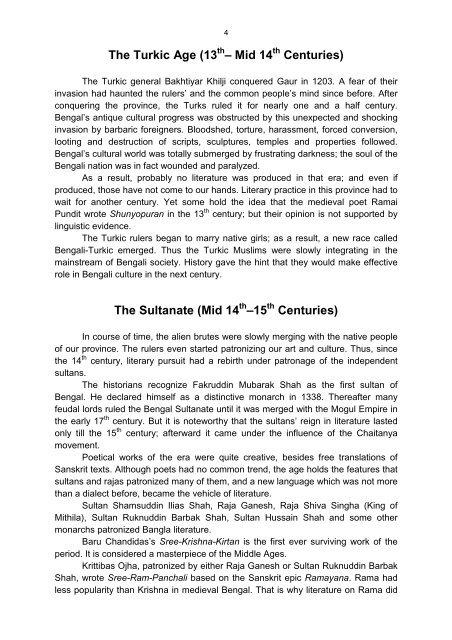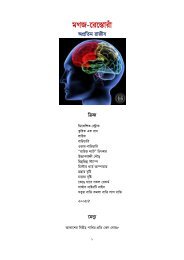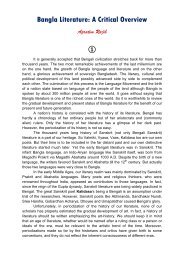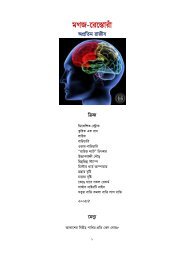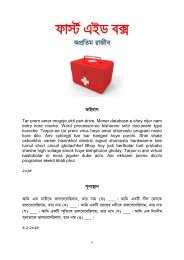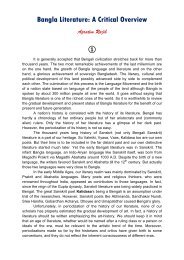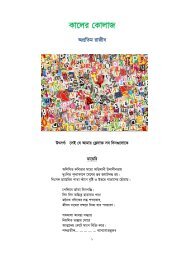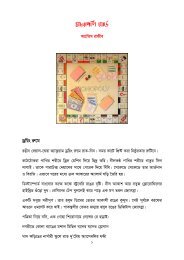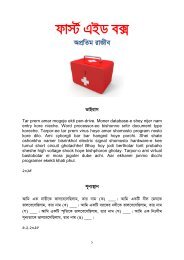BLiterature-Apratim
You also want an ePaper? Increase the reach of your titles
YUMPU automatically turns print PDFs into web optimized ePapers that Google loves.
4<br />
The Turkic Age (13 th – Mid 14 th Centuries)<br />
The Turkic general Bakhtiyar Khilji conquered Gaur in 1203. A fear of their<br />
invasion had haunted the rulers’ and the common people’s mind since before. After<br />
conquering the province, the Turks ruled it for nearly one and a half century.<br />
Bengal’s antique cultural progress was obstructed by this unexpected and shocking<br />
invasion by barbaric foreigners. Bloodshed, torture, harassment, forced conversion,<br />
looting and destruction of scripts, sculptures, temples and properties followed.<br />
Bengal’s cultural world was totally submerged by frustrating darkness; the soul of the<br />
Bengali nation was in fact wounded and paralyzed.<br />
As a result, probably no literature was produced in that era; and even if<br />
produced, those have not come to our hands. Literary practice in this province had to<br />
wait for another century. Yet some hold the idea that the medieval poet Ramai<br />
Pundit wrote Shunyopuran in the 13 th century; but their opinion is not supported by<br />
linguistic evidence.<br />
The Turkic rulers began to marry native girls; as a result, a new race called<br />
Bengali-Turkic emerged. Thus the Turkic Muslims were slowly integrating in the<br />
mainstream of Bengali society. History gave the hint that they would make effective<br />
role in Bengali culture in the next century.<br />
The Sultanate (Mid 14 th –15 th Centuries)<br />
In course of time, the alien brutes were slowly merging with the native people<br />
of our province. The rulers even started patronizing our art and culture. Thus, since<br />
the 14 th century, literary pursuit had a rebirth under patronage of the independent<br />
sultans.<br />
The historians recognize Fakruddin Mubarak Shah as the first sultan of<br />
Bengal. He declared himself as a distinctive monarch in 1338. Thereafter many<br />
feudal lords ruled the Bengal Sultanate until it was merged with the Mogul Empire in<br />
the early 17 th century. But it is noteworthy that the sultans’ reign in literature lasted<br />
only till the 15 th century; afterward it came under the influence of the Chaitanya<br />
movement.<br />
Poetical works of the era were quite creative, besides free translations of<br />
Sanskrit texts. Although poets had no common trend, the age holds the features that<br />
sultans and rajas patronized many of them, and a new language which was not more<br />
than a dialect before, became the vehicle of literature.<br />
Sultan Shamsuddin Ilias Shah, Raja Ganesh, Raja Shiva Singha (King of<br />
Mithila), Sultan Ruknuddin Barbak Shah, Sultan Hussain Shah and some other<br />
monarchs patronized Bangla literature.<br />
Baru Chandidas’s Sree-Krishna-Kirtan is the first ever surviving work of the<br />
period. It is considered a masterpiece of the Middle Ages.<br />
Krittibas Ojha, patronized by either Raja Ganesh or Sultan Ruknuddin Barbak<br />
Shah, wrote Sree-Ram-Panchali based on the Sanskrit epic Ramayana. Rama had<br />
less popularity than Krishna in medieval Bengal. That is why literature on Rama did


